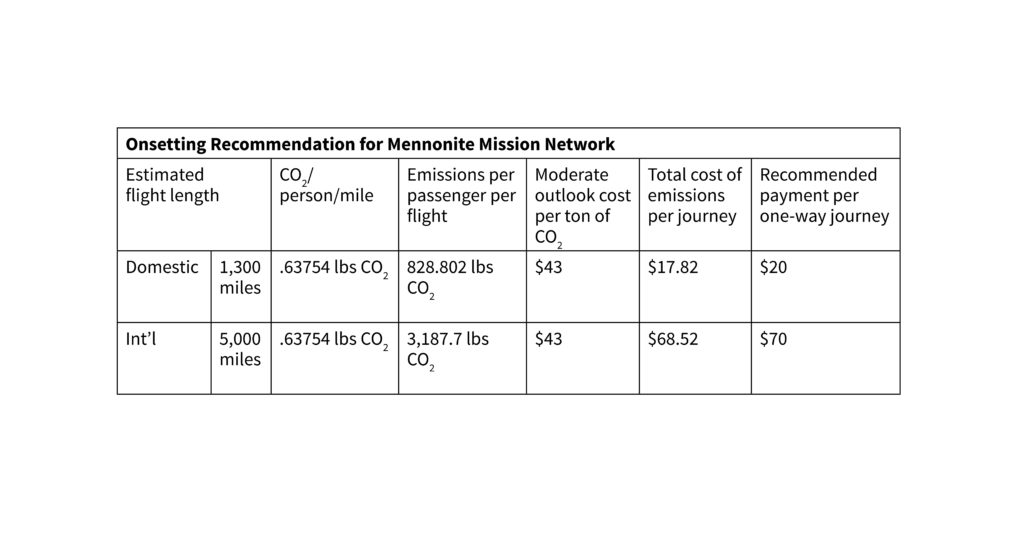As Anabaptists work to share the whole gospel with the whole world, they rarely stop to examine the environmental impact of their international presence. Mennonite agencies, especially in North America, assume that air travel is a required part of providing humanitarian relief, education, church plants, and/or economic development for communities around the world. Their travel, however, results in carbon emissions that are detrimental to the environment. Repairing this environmental damage is imperative, from both scriptural and systems-thinking standpoints.
This article serves as a case study in implementing carbon onsetting to offset the negative impact of carbon emissions created by international nonprofit air travel. Mennonite Mission Network (MMN), the mission agency of Mennonite Church USA,1 is an ideal candidate for the study since the agency is responsible for more than 150 workers in 52 countries and provides service opportunities for thousands of people in North America each year. MMN’s stated goal is “to lead, mobilize, and equip the church to participate in holistic witness to Jesus Christ in a broken world”;2 to fulfill that goal, staff and volunteers regularly travel to Europe, Asia, Latin America, and Africa. Their travel supports church growth, pastoral training, discipleship, relief work, and development efforts. Ultimately, the scope of MMN’s involvement affects thousands of lives.
The study’s conclusion is that agencies like MMN could reasonably onset emissions from their air travel and invest in partner agencies committed to preserving God’s creation, by increasing their budgets to account for each flight—currently, by $20 per one-way domestic flight within the United States and $70 per one-way international flight originating in the United States.
Background
Anabaptist agencies like MMN who depend on travel by air to carry out their mission are responsible for contributing to greenhouse gas emissions through their travel—most specifically, for creating carbon dioxide, or CO2. As a gas, CO2 allows the visible light from the sun to pass through it. The visible light is absorbed by the earth, which then releases infrared radiation. This is a problem because while CO2 does not absorb visible light, it does absorb infrared radiation. This in turn causes an increase in global temperature,3 which leads to drought, melting glaciers, rising ocean levels, and erratic weather patterns. As a result, people who are in coastal areas or dependent on agriculture are negatively affected by habitat destruction, property destruction, and reduced crop yields. All of these effects are commonly referred to as climate change.
There are many ways to respond to the problem of carbon emissions; two of these include carbon offsetting and carbon onsetting. Carbon offsetting seeks to withdraw emitted carbon from the atmosphere, usually through planting trees or preserving forests. Typically, organizations that participate in offsetting pay $12 to $20 per ton of CO2.4 While this is a low-cost option for taking responsibility for carbon emissions, a single tree may need close to a decade to sequester a ton of carbon.5 When that tree dies, the carbon it sequestered is released back into the atmosphere through burning or decomposition.
Carbon onsetting, comparatively, seeks to recognize the societal impact of a ton of carbon, should it remain in the atmosphere. Onsetting, which is a relatively new concept, focuses less on an exact accounting of carbon emissions and more on a commitment to invest in causes that benefit the environment and the local community. According to the EPA, one ton of CO2 will have $43 of negative impact on society through increased health costs, habitat destruction, and desertification. This cost is predicted to rise each year as long as there is no change in the rate of carbon emissions.6After calculating their carbon emissions, organizations who participate in carbon onsetting pay the societal cost per ton of carbon rather than the cost to remove it. This cost per ton is invested in causes like local food co-ops, arboretums, and green initiatives that have explicit positive environmental impacts. These causes don’t provide a dollar-for-dollar amount of carbon reduction. Instead, they have an impact in the local community while addressing the social impacts of climate change.
Application
While an onsetting proposal could include estimates of emissions from vehicle travel, office buildings, and/or supplies, this proposal focuses specifically on air travel. The rationale for this is twofold: (1) travel by plane emits much more carbon than travel by vehicle, and air travel is a significant part of MMN’s work; (2) there are limited options for taking environmental responsibility for air travel—a company can commit to renting hybrid cars, using recycled goods, or installing solar on office buildings, but few such alternatives exist for air travel.
In terms of strategy for onsetting, the best proposal will be a simple one since, especially in MMN’s case, calculating or predicting the exact annual travel by plane is a difficult proposition. Changes in worker assignments, new partnerships, and biannual events mean that the year-to-year travel in miles fluctuates. Keeping exact tallies of all miles flown would require strict accountability from close to 200 workers and staff.
The proposal outlined below works at simplifying through use of averages and estimates. According to a 2014 report from the Bureau of Transportation, the average domestic passenger trip length is 1,424 miles one-way.7 Passengers traveling internationally from the United States flew an average of 3,294 miles one-way. Since MMN does not often fly to Central America or the Caribbean, the average trip length for an international trip in the proposal has been rounded up to 5,000 miles one-way. (For reference, a flight from Chicago O’Hare Airport to Charles de Gaulle airport in Paris clocks in at 4,200 miles.) Additionally, the miles for domestic flights have been rounded down since the majority of the agency’s constituency is located in the Midwest and the number of flight miles is most likely lower than average.
Further information on emissions comes from the United Kingdom. Each year, the UK government puts together a report on conversion factors for CO2 emissions. For 2016, the report sets the emissions for a short-haul flight (within Europe) at 0.16844 kilograms of CO2 per kilometer flown. For a long-haul flight (outside of Europe), the average emissions are 0.19162 kg/CO2 per kilometer flown. And for a trans-oceanic flight, the average emissions are 0.17901 kg/CO2 per kilometer flown.8
Averaging these three values gives the reasonable approximation of .17969 kilograms of CO2 produced per kilometer flown. Conversion to imperial units gives 0.39615 pounds of CO2 per kilometer flown, or, .63754 pounds of CO2 per mile.
The simplest path forward would be to apply these onsetting amounts (adjusted as needed to account for the changing cost per ton of carbon emissions) to all future air travel paid for by MMN. Thus, any round-trip flight booked by employees or mission workers within the United States would currently have a $40 charge added to the overall expense, and international flights would cost an additional $140. To ensure that these funds would not simply serve to enrich Mennonite Mission Network, they should be placed in a separate fund distributed to partner agencies on an annual basis and reported to the board.
Multiple organizations within MMN’s sphere of relationship and influence would be excellent candidates for the agency’s onsetting investments.
- The Dyck Arboretum in Hesston, Kansas, and the Elkhart Environmental Center both seek to preserve native habitats and to educate residents about the world around them.
- Chain Reaction in Goshen, Indiana, provides people with reliable, green transportation by allowing people in poverty to pay for bicycles through working at the shop. A gift to this agency serves both planet and people.
- The money set aside for carbon onsetting could also be directed toward current projects of MMN. Participants in Mennonite Voluntary Service serve in community gardens and food co-ops; participants in the SOOP program serve in food banks and assist with home repair. Similarly, workers in Ecuador are partnering with local people to help them establish their own eco-tourism venture.
- Finally, there are a variety of organizations within the Mennonite world that work to combat the effects of climate change. Mennonite Creation Care Network9 is a collaboration of several Mennonite agencies, including Mennonite Church USA, which seek to bring together faith-based people in creation care. Much of their work is centered on informing and resourcing; they also provide grants for churches to reduce their carbon footprint to zero.
Conclusion
Responding to the carbon emissions resulting from travel is central to the call of Anabaptist agencies to holistically care for all of creation. Although both carbon offsetting and carbon onsetting can be used to address the negative effects of carbon emissions, carbon onsetting is a more responsible approach as it provides a higher estimate of the social cost of emissions, allows for greater flexibility in response, and is based within local communities. Estimates in this paper have shown that MMN could use carbon onsetting to authentically address their air travel carbon emissions through increasing their budget by $20 for each one-way domestic flights and $70 for each one-way international flight. The funds generated would support organizations whose mission is to positively impact the local environment.
As MMN and other Anabaptists work to serve the whole world as messengers of Christ, taking small steps like onsetting could result in air travel that is not only environmentally responsible but also beneficial to the work of partners in mission around the world.
Matt Lehman Wiens is Director of Donor Relations for Mennonite Mission Network. He wrote this paper as part of the Collaborative MBA joint program of Bluffton University, Canadian Mennonite University, Eastern Mennonite University, and Goshen College. He lives in Wichita, Kansas, with his wife.
Footnotes
Mennonite Mission Network denominational offices are located in Elkhart, Indiana, and Newton, Kansas.
“Mission and Vision,” Home page, Mennonite Mission Network, last modified 2016, https://www.mennonitemission.net/about/Mission%20and%20Vision.
J. D. Sachs, The Age of Sustainable Development (New York: Columbia University Press, 2015).
Daniel Greenberg, ed., “What is Onsetting?” Earthdeeds, 2015, accessed December 11, 2016, http://earthdeeds.org/onsetting.php.
Amy Wotherspoon et al., “Carbon Sequestration Potential of Five Tree Species in a 25-Year-Old Temperate Tree-based Intercropping System in Southern Ontario, Canada,” Agroforestry Systems 88, no. 4 (2014): 631–43.
Greenberg, ed., “What is Onsetting?”
Dave Smallen, “Summary 2014 U.S.-based Airline Traffic Data,” Bureau of Transportation Statistics press release, United Bureau of Transportation, March 26, 2015, http://www.rita.dot.gov/bts/press_releases/bts015_15.
“Greenhouse Gas Reporting—Conversion Factors 2016,” UK Government, October 5, 2016, https://www.gov.uk/government/publications/greenhouse-gas-reporting-conversion-factors-2016.
See Mennonite Creation Care Network at http://www.mennocreationcare.org/.

